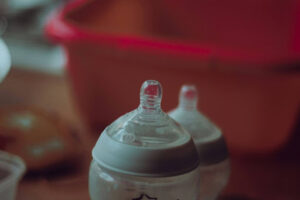
Breastfeeding mothers often hear about how “liquid gold” breast milk perfectly suits their baby’s needs. But for some moms, pumping and storing breast milk can come with an unexpected challenge—high-lipase breast milk. This natural occurrence can cause pumped milk to develop a soapy or metallic taste over time, leading many babies to reject it.
If you’ve ever noticed your baby turning away from stored milk, high lipase could be the culprit. Fortunately, there’s a solution that doesn’t require tossing your precious supply. Enter freeze drying breast milk—a modern method that’s changing the game for moms dealing with high-lipase issues.
In this article, we’ll explore high-lipase breast milk, how it affects storage, and why freeze drying could be your best option.
What Is High-Lipase Breast Milk?
Lipase is an enzyme naturally present in all breast milk. Its role is to break down fats into fatty acids, making them easier for babies to digest. This enzyme usually works quietly in the background without causing any problems.
But in some moms, lipase is more active than usual. When breast milk is stored—especially in the fridge or freezer—this excess activity can alter taste and smell, even if the milk is still perfectly safe and nutritious.
The result? Milk that tastes soapy, metallic, or sour after just a few hours or days in storage. Babies who are sensitive to taste changes may refuse to drink it.
How to Tell if You Have High-Lipase Breast Milk

If you suspect high lipase might be an issue, here’s a simple test:
- Pump a small amount of milk and store it in the fridge.
- Taste and smell it fresh, then again after 24, 48, and 72 hours.
- If the milk starts to smell or taste soapy, fishy, or metallic while still being stored properly, high lipase is likely to blame.
Keep in mind, high lipase isn’t harmful—it’s just inconvenient. But for moms with full freezers or babies who refuse the altered milk, it can be incredibly frustrating.
Traditional Fixes: Scalding Milk
Before freeze drying became widely accessible, the most common method for preventing high-lipase human milk from changing taste was scalding milk immediately.
Scalding involves heating freshly pumped milk to around 180°F (just below boiling) and then quickly cooling it before storage. This deactivates the lipase enzyme, preventing it from breaking down fats.
While effective, scalding has several drawbacks:
- It’s time-consuming
- You risk overheating and damaging nutrients, antibodies, as well as pre/probiotics
- It must be done immediately after pumping
- It requires extra equipment and constant monitoring
Busy moms don’t always have time to stand over a stove, especially when pumping multiple times a day.
Why Freeze Drying Is a Game Changer for High-Lipase Breast Milk
Thanks to innovations like BoobieJuice’s freeze drying process, there’s now a smarter, more convenient option for handling high-lipase milk. Freeze drying not only preserves the milk’s nutrients—it also halts the enzymatic activity of lipase, locking in both taste and quality. It also has a key benefit of improving the overall taste and aroma of milk already impacted by the effects of higher lipase.
Here’s how it works:
- You ship frozen milk to BoobieJuice
- It’s freeze dried into a shelf-stable powder
- The powder is sealed in air-tight, light-proof pouches
- You rehydrate it later by adding warm water—anytime, anywhere
This method naturally deactivates lipase without the use of high heat, meaning no nutrient loss and no need to rush to scald every batch.
Key Benefits of Freeze Drying for High-Lipase Milk

Preserves Taste & Smell
Freeze drying stops the lipase activity before it affects the flavor, so your baby gets milk that smells and tastes just like it did when pumped—no more bottle rejection.
Improves Taste & Aroma
Freeze drying tends to help improve the overall taste and aroma of frozen milk stashes, helping mom put all that stored milk to work.
Retains Nutritional Value
Unlike scalding, freeze drying keeps all the bioactive nutrients, antibodies, and enzymes that make freshly expressed milk so valuable.
No Rush to Use It
Freeze dried breast milk can last for years when stored properly, giving you peace of mind and flexibility.
Space-Saving Storage
Powder takes up significantly less space than frozen bags, making it perfect for travel, daycare, or long-term storage.
Convenient for On-the-Go
Just add water to rehydrate and feed your baby anytime—no need to thaw, warm, or worry about spoilage.
Fortify all of Baby’s Food
Breast milk powder can be incorporated into all of your baby’s favorite foods by simply mixing it in or sprinkling it on.
Who Should Consider Freeze Drying?
Freeze drying is especially useful for moms who:
- Know they have high-lipase breast milk
- Have babies rejecting stored milk
- Want to stop scalding every batch
- Need longer-term or more portable storage
- Are returning to work or traveling frequently
- Are building a milk stash for future use (e.g., NICU stays, emergencies, or donations)
Even if your baby isn’t rejecting milk now, freeze drying is a proactive step to preserve quality without compromise.
Final Thoughts
If high-lipase breast milk is getting in the way of your pumping or breastfeeding journey, you’re not alone—and you don’t have to throw away your hard work. Freeze drying your breast milk with BoobieJuice is an effective, safe, and hassle-free way to preserve milk taste, quality, and nutrients for the long haul.
Modern problems deserve modern solutions, and freeze drying might just be the breakthrough you’ve been waiting for.
FAQ: High-Lipase Breast Milk
Is high-lipase breast milk bad for my baby?
No. High-lipase milk is still completely safe and nutritious. The only issue is taste—some babies are sensitive to the flavor changes that happen during storage.
Can I still feed my baby high-lipase milk if they’ll take it?
Yes! If your baby doesn’t seem to mind the altered taste or smell, you don’t need to do anything differently. If your goal is storing milk long term, you will want to look at options to halt lipase from continuing to impact the milk.
How quickly does high lipase affect stored milk?
It varies. Some moms notice changes after 24 hours in the fridge, while others see it after a few days. Freezing can also slow the process, but may not stop it entirely.
Will freezing stop lipase from working?
Not completely. Freezing slows enzyme activity but doesn’t fully deactivate lipase, which means flavor changes can still occur over time in frozen milk.
What’s the best way to prevent high-lipase milk from going “bad”?
Scalding can stop the enzyme, but may damage nutrients. Freeze drying is a gentler and more effective way to preserve taste without nutrient loss.
Can freeze dried breast milk be used in bottles just like fresh milk?
Yes! Once rehydrated, freeze dried breast milk functions just like regular milk—perfect for bottles, cups, or mixing with solids.
How long does freeze dried breast milk last?
When stored in a cool, dark place in its sealed pouch, BoobieJuice freeze dried breast milk can last up to 3 years.
Do I need to scald milk before freeze drying?
No! One of the biggest benefits of freeze drying is that there’s no need to scald. The process itself halts the lipase enzyme activity and can improve the taste and aroma of the already affected milk.
Freeze Dry Breast Milk with BoobieJuice
BoobieJuice is a cGMP-certified freeze dried breast milk facility that freeze dries your breast milk. We have local drop-off options so moms can drop off their milk at their facility in Arizona. For out-of-state moms, we provide everything you need to safely package and ship your breast milk to them. Want to learn more about how to stop lipase in breast milk or how to have your breast milk freeze dried? Visit our website BoobieJuice.com for more information.
